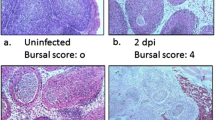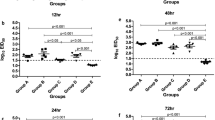Abstract
Very virulent infectious bursal disease virus (vvIBDV) targets B lymphocytes in the bursa of Fabricius (BF), causing immunosuppression and increased mortality rates in young birds. There have been few studies on the host immune response following vvIBDV infection at different inoculum doses in chickens with different genetic backgrounds. In this study, we characterized the immune responses of specific-pathogen-free (SPF) chickens and Malaysian red jungle fowl following infection with vvIBDV strain UPM0081 at 103.8 and 106.8 times the 50% embryo infectious dose (EID50). The viral burden, histopathological changes, immune cell populations, and expression of immune-related genes were measured and compared between infected and uninfected bursa at specific intervals. The populations of KUL1+, CD3+CD4+ and CD3+CD8+ cells were significantly increased in both types of chickens at 3 dpi, and there was significant early depletion of IgM+ B cells at 1 dpi in the red jungle fowl. vvIBDV infection also induced differential expression of genes that are involved in Th1 and pro-inflammatory responses, with groups receiving the higher dose (106.8 EID50) showing earlier expression of IFNG, IL12B, IL15, IL6, CXCLi2, IL28B, and TLR3 at 1 dpi. Although both chicken types showed equal susceptibility to infection, the red jungle fowl were clinically healthier than the SPF chickens despite showing more depletion of IgM+ B cells and failure to induce IFNB activation. In conclusion, high-dose vvIBDV infection caused an intense early host immune response in the infected bursa, with depletion of IgM+ B cells, bursal lesions, and cytokine expression as a response to mitigate the severity of the infection.




Similar content being viewed by others
References
Dobos P, Hill BJ, Hallett R, Kells DT, Becht H, Teninges D (1979) Biophysical and biochemical characterization of five animal viruses with bisegmented double-stranded RNA genomes. J Virol 32:593–605
Sharma JM, Kim IJ, Rautenschlein S, Yeh HY (2000) Infectious bursal disease virus of chickens: pathogenesis and immunosuppression. Dev Comp Immunol 24:223–235
Muller H, Mundt E, Eterradossi N, Islam MR (2012) Current status of vaccines against infectious bursal disease. Avian Pathol 41:133–139
Brown MD, Green P, Skinner MA (1994) VP2 sequences of recent European “very virulent” isolates of infectious bursal disease virus are closely related to each other but are distinct from those of “classical” strains. J Gen Virol 75:675–680
Nunoya T, Otaki Y, Tajima M, Hiraga M, Saito T (1992) Occurrence of acute infectious bursal disease with high mortality in Japan and pathogenicity of field isolates in specific-pathogen-free chickens. Avian Dis 36:597–609
Hair-Bejo M (1992) An outbreak of infectious bursal disease in broilers. J Vet Malaysia 4:168
Tan DY, Hair-Bejo M, Omar AR, Aini I (2004) Pathogenicity and molecular analysis of an infectious bursal disease virus isolated from Malaysian village chickens. Avian Dis 48:410–416
Nurulfiza I, Hair-Bejo M, Omar AR, Aini I (2006) Molecular characterization of recent infectious bursal disease virus isolates from Malaysia. Acta Virol 50:45–51
Scanavini Neto H, Ito NMK, Miyaji CI, Lima EDA, Okayabayashi S, Correa ARA, Eleuterio GC, Zuanaze MA (2004) Infectious bursal disease virus: case report and experimental studies in vaccinated and unvaccinated SPF chickens and commercial broiler chicks. Braz J Poultry Sci 61:41–54
Jackwood DJ, Sommer-Wagner SE, Stoute ST, Woolcock PR, Crossley BM, Hietala SK, Charlton BR (2009) Characteristics of a very virulent infectious bursal disease virus from California. Avian Dis 53:592–600
Kim IJ, You SK, Kim H, Yeh HY, Sharma JM (2000) Characteristics of bursal T lymphocytes induced by infectious bursal disease virus. J Virol 74:8884–8892
Khatri M, Palmquist JM, Cha RM, Sharma JM (2005) Infection and activation of bursal macrophages by virulent infectious bursal disease virus. Virus Res 113:44–50
Yasmin AR, Yeap SK, Hair-Bejo M, Omar AR (2016) Characterization of chicken splenic-derived dendritic cells following vaccine and very virulent strains of infectious bursal disease virus infection. Avian Dis 60:739–751
Yasmin AR, Yeap SK, Tan SW, Hair-Bejo M, Fakurazi S, Kaiser P, Omar AR (2015) In vitro characterization of chicken bone marrow-derived dendritic cells following infection with very virulent infectious bursal disease virus. Avian Pathol 44:452–462
Eldaghayes I, Rothwell L, Williams A, Withers D, Balu S, Davison F, Kaiser P (2006) Infectious bursal disease virus: strains that differ in virulence differentially modulate the innate immune response to infection in the chicken bursa. Viral Immunol 19:83–91
Ulfah M, Kawahara-Miki R, Farajalllah A, Muladno M, Dorshorst B, Martin A, Kono T (2016) Genetic features of red and green junglefowls and relationship with Indonesian native chickens Sumatera and Kedu Hitam. BMC Genom 17:320
Xiang H, Gao J, Yu B, Zhou H, Cai D, Zhang Y, Chen X, Wang X, Hofreiter M, Zhao X (2014) Early Holocene chicken domestication in northern China. Proc Natl Acad Sci USA 111:17564–17569
Psifidi A, Banos G, Matika O, Desta TT, Bettridge J, Hume DA, Dessie T, Christley R, Wigley P, Hanotte O, Kaiser P (2016) Genome-wide association studies of immune, disease and production traits in indigenous chicken ecotypes. Genet Sel Evol 48:74
Hanh NTH, Thuy LT, Han J, Silva P, Ibrahim MNM, Okeyo AM (2015) Morphological characteristics and growth performance of F1 hybrids of red junglefowl cocks crossed with Fayoumi or H’mong Hens. Trop Agric Res 26:655–665
Downing T, Lloyd AT, O’Farrelly C, Bradley DG (2010) The differential evolutionary dynamics of avian cytokine and TLR gene classes. J Immunol 184:6993–7000
Wallis JW, Aerts J, Groenen MAM, Crooijmans RPMA, Layman D, Graves TA, Scheer DE, Kremitzki C, Fedele MJ, Mudd NK, Cardenas M, Higginbotham J, Carter J, McGrane R, Gaige T et al (2004) A physical map of the chicken genome. Nature 432:761–764
Sun YH, Xie LH, Zhuo X, Chen Q, Ghoneim D, Zhang B, Jagne J, Yang C, Li XZ (2017) Domestic chickens activate a piRNA defense against avian leukosis virus. eLife 6:e24695
Iqbal M, Yaqub T, Mukhtar N, Shabbir MZ, McCauley JW (2013) Infectivity and transmissibility of H9N2 avian influenza virus in chickens and wild terrestrial birds. Vet Res 44:100
Reed LJ, Muench H (1938) A simple method estimating fifty per cent endpoints. Am J Epidemiol 27:493–497
Konto M, Fufa GI, Zakaria A, Tukur SM, Watanabe M, Ola-Fadunsin SD, Khan MS, Shettima YM, Babjee SMA (2015) Tick fauna of Malaysian red jungle fowl (Gallus gallus) in Bangi, Malaysia. Vet World 8:1167–1171
Cazaban C, Majo Masferrer N, Dolz Pascual R, Nofrarias Espadamala M, Costa T, Gardin Y (2015) Proposed bursa of fabricius weight to body weight ratio standard in commercial broilers. Poult Sci 94:2088–2093
Fischer AH, Jacobson KA, Rose J, Zeller R (2008) Paraffin embedding tissue samples for sectioning. CSH Protoc 2008:pdb-prot4989
Sharma JM, Dohms JE, Metz AL (1989) Comparative pathogenesis of serotype 1 and variant serotype 1 isolates of infectious bursal disease virus and their effect on humoral and cellular immune competence of specific-pathogen-free chickens. Avian Dis 33:112–124
Rasoli M, Yeap SK, Tan SW, Roohani K, Kristeen-Teo YW, Alitheen NB, Rahaman YA, Aini I, Bejo MH, Kaiser P, Omar AR (2015) Differential modulation of immune response and cytokine profiles in the bursae and spleen of chickens infected with very virulent infectious bursal disease virus. BMC Vet Res 11:75
Pfaffl MW (2001) A new mathematical model for relative quantification in real-time RT-PCR. Nucleic Acids Res 29:e45
Ingrao F, Rauw F, Lambrecht B, Van den Berg T (2013) Infectious bursal disease: a complex host–pathogen interaction. Dev Comp Immunol 41:429–438
Tippenhauer M, Heller DE, Weigend S, Rautenschlein S (2013) The host genotype influences infectious bursal disease virus pathogenesis in chickens by modulation of T cells responses and cytokine gene expression. Dev Comp Immunol 40:1–10
Mohammed MH, Hair-Bejo M, Omar AR, Aini I, Hasoon MF (2011) Immune response to killed very virulent infectious bursal disease virus by water-catholyte-anolyte in specific-pathogenic-free chickens. J World Poult Res 1:22–26
Vervelde L, Davison TF (1997) Comparison of the in situ changes in lymphoid cells during infection with infectious bursal disease virus in chickens of different ages. Avian Pathol 26:803–821
Withers DR, Davison TF, Young JR (2006) Diversified bursal medullary B cells survive and expand independently after depletion following neonatal infectious bursal disease virus infection. Immunology 117:558–565
Rauf A, Khatri M, Murgia M, Saif YM (2011) Expression of perforin–granzyme pathway genes in the bursa of infectious bursal disease virus-infected chickens. Dev Comp Immunol 35:620–627
Rautenschlein S, Yeh HY, Njenga MK, Sharma JM (2002) Role of intrabursal T cells in infectious bursal disease virus (IBDV) infection: T cells promote viral clearance but delay follicular recovery. Arch Virol 147:285–304
Liu H, Zhang M, Han H, Yuan J, Li Z (2010) Comparison of the expression of cytokine genes in the bursal tissues of the chickens following challenge with infectious bursal disease viruses of varying virulence. Virol J 7:364
Palmquist JM, Khatri M, Cha RM, Goddeeris BM, Walcheck B, Sharma JM (2006) In vivo activation of chicken macrophages by infectious bursal disease virus. Viral Immunol 19:305–315
Rauf A, Khatri M, Murgia MV, Saif YM (2012) Fas/FasL and perforin–granzyme pathways mediated T cell cytotoxic responses in infectious bursal disease virus infected chickens. Results Immunol 2:112–119
Rauf A, Khatri M, Murgia MV, Jung K, Saif YM (2011) Differential modulation of cytokine, chemokine and Toll like receptor expression in chickens infected with classical and variant infectious bursal disease virus. Vet Res 42:85
Raj GD, Rajanathan TMC, Kumanan K, Elankumaran S (2011) Changes in the cytokine and toll-like receptor gene expression following infection of indigenous and commercial chickens with infectious bursal disease virus. Indian J Virol 22:146–151
He X, Chen Y, Kang S, Chen G, Wei P (2017) Differential regulation of chTLR3 by infectious bursal disease viruses with different virulence in vitro and in vivo. Viral Immunol 30:490–499
Cheeseman JH, Levy NA, Kaiser P, Lillehoj HS, Lamont SJ (2008) Salmonella enteritidis–induced alteration of inflammatory CXCL chemokine messenger-RNA expression and histologic changes in the ceca of infected chicks. Avian Dis 52:229–234
Reuter A, Soubies S, Härtle S, Schusser B, Kaspers B, Staeheli P, Rubbenstroth D (2014) Antiviral activity of lambda interferon in chickens. J Virol 88:2835–2843
Farhanah MI, Yasmin AR, Mat Isa N, Hair-Bejo M, Ideris A, Powers C, Oladapo O, Nair V, Khoo JS, Ghazali AK, Yee WY, Omar AR (2017) Bursal transcriptome profiling of different inbred chicken lines reveals key differentially expressed genes at 3 days post-infection with very virulent infectious bursal disease virus. J Gen Virol 99:21–35
Ank N, Iversen MB, Bartholdy C, Staeheli P, Hartmann R, Jensen UB, Dagnaes-Hansen F, Thomsen AR, Chen Z, Haugen H, Klucher K, Paludan SR (2008) An important role for type III interferon (IFN-λ/IL-28) in TLR-induced antiviral activity. J Immunol 180:2474–2485
Morrow MP, Pankhong P, Laddy DJ, Schoenly KA, Yan J, Cisper N, Weiner DB (2009) Comparative ability of IL-12 and IL-28B to regulate Treg populations and enhance adaptive cellular immunity. Blood 113:5868–5877
Acknowledgements
This study was supported by the Institute of Bioscience, Higher Institution Centre of Excellence (IBS HICoE) Grant no. 6369101 from the Ministry of Higher Education, Government of Malaysia.
Author information
Authors and Affiliations
Corresponding author
Ethics declarations
Ethical approval
All applicable institutional guidelines for the care and use of animals were followed.
Conflict of interest
The authors declare that they have no conflict of interest.
Additional information
Handling Editor: Zhenhai Chen.
Rights and permissions
About this article
Cite this article
Farhanah, M.I., Yasmin, A.R., Khanh, N.P. et al. Bursal immunopathology responses of specific-pathogen-free chickens and red jungle fowl infected with very virulent infectious bursal disease virus. Arch Virol 163, 2085–2097 (2018). https://doi.org/10.1007/s00705-018-3841-7
Received:
Accepted:
Published:
Issue Date:
DOI: https://doi.org/10.1007/s00705-018-3841-7




